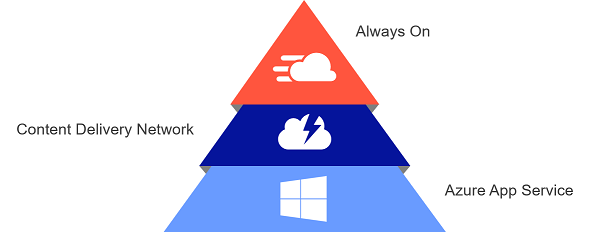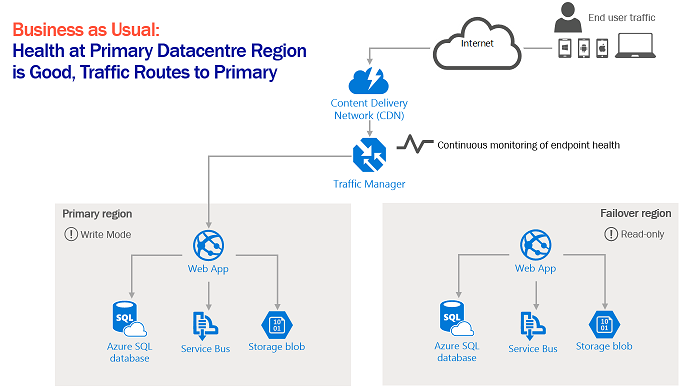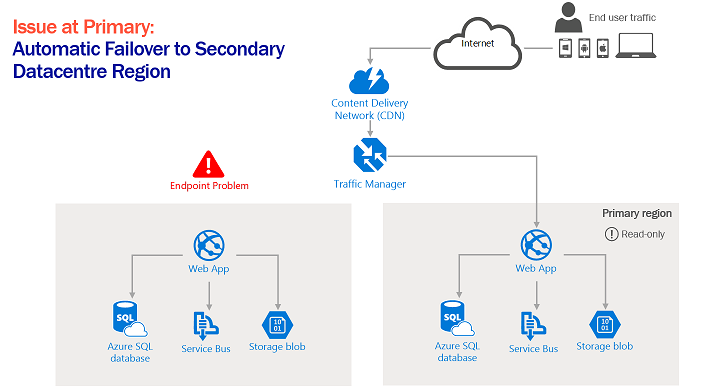Episerver’s Digital Experience Cloud™ Automatic Failover Solution
The standard delivery of the Episerver Digital Experience Cloud™ Service ensures high availability through round the clock monitoring, utilization of scalable and highly resilient cloud technology, backed by Episerver’s global Managed Service Desk operating a “follow the sun” support function to our customers.
The Standard Service Resilience

The Episerver Digital Experience Cloud™ Service itself is based largely on Microsoft cloud technology. One of the key reasons why Episerver choose Microsoft Azure to underpin our service is its resilience. Microsoft Azure ensures fast and reliable connectivity to cloud services and data and Microsoft maintains capacity to handle large-scale network interruptions without degradation of performance.
Within the Digital Experience Cloud™ Service, Microsoft Azure provides full load balancing and scaling, all handled automatically for you behind your Episerver application. The Digital Experience Cloud™ Service’s uses Azure App Service within each environment which ramp up the number of running instances to handle increased load, on demand (the ramp up based on performance thresholds). All data is stored in “storage accounts” that are continuously geo-replicated to a secondary datacenter. If the hardware fails on the primary replica, the secondary replica can be quickly brought online. In case of a physical loss of a replica, a new replica is automatically created. So, there are always at minimum two physical, transactional consistent copies of your data in separate datacenters.
On top of the Microsoft Azure PaaS layer, Episerver’s Digital Experience Cloud™ Service includes a Content Delivery Network consisting of a globally distributed network of proxy servers (nodes) deployed in multiple datacenters. CDNs will deliver content to your visitors from the fastest and closest edge servers available. By reducing the number of service requests to origin from geographically dispersed locations, more requests can be managed and provided from edge servers closest to the visitor location, resulting in a faster browsing experience. Our CDN has near to 120 global node locations, it’s an extremely large global Anycast network (size of 10 Tbsp, which is 10X bigger than the largest DDoS attack ever recorded), which provides our customers peace of mind that the service can withstand massive DDoS attacks and provide visitors multiple paths to the service, even in the event of an edge server failure.
In addition, Episerver’s Digital Experience Cloud™ Service has an Always Online feature enabled, which always keeps a limited version your website available. So, even if your services primary datacenter region is unavailable, the Always Online feature will continue to serve important traffic pages from cache. When the primary Azure delivery region is back online, regular browsing returns seamlessly. If the service does not have the requested page in its cache, the visitor will see an error page to let them know that the website page they are requesting is offline. The Always Online feature works by crawling through customers' pages daily and statistically picking the most used pages to prioritize them in cache, you are unable to select or “pin” these pages to cache it’s fully automated within the Service.
You’re Only as Strong as Your Weakest Link
Whilst Microsoft Azure is highly resilient, it still represents a single point of failure in the standard Digital Experience Cloud™ Service. Even with the Always On feature, you will never have full certainty that all priority pages will be cached when primary is unavailable, meaning that you run the risk of error pages being served to your customers in the event of an outage at primary. Also, the pages served to your visitors will always be static content.
In practice in the unlikely, but possible event of a total disaster at a primary, Episerver’s Managed Service Desk would require rebuilding your website from the replicated backups stored at secondary datacenter region, within that region. This process will not be automatic and would require Episerver’s Managed Service Desk to follow our Incident Management Process (Category P1 incident, Target Resolution Time 2 hours), to rebuild your service from scratch using the replicated backups. So, this could result in potentially hours of website downtime.
What’s the Cost of Downtime?
There are several different variables that will have a direct and indirect cost to your business because of website downtime.
The size of your company is obviously one factor, but it’s how your customers interact with your business that will determine the actual impact. If your business is predominately online, the result will be catastrophic. Calculate per hour or minute of the resultant cost to your business because of website downtime, from the areas identified below.
1. Damage to your Reputation and Trust
There’s an expectation today that website’s will be always on, outages will be viewed as unacceptable to your visitors. Across all sectors there’s increasing service and price competition, meaning that in today’s market customers will be much less understanding and patient. You need to negate any reason for your customers to look towards the competition, especially over something avoidable like a website outage. It takes a lot to earn customers’ trust and loyalty, but this can be lost quickly. Visitors may even turn to social media to vent their anger or dissatisfaction, the result to your brand could ripple out to your customer base unmeasurably.
2. Loss of Business
Your website being offline is the equivalent of a bricks and mortar retail store, fully staffed and stocked, with the lights on, but the front door closed. If your website is down, your visitors will be totally unable to accomplish the goals of your website, whether that’s driving leads, trading or providing information. Even once your website site’s back online after an elapsed period, it’s still uncertain whether your visitors will return – the damage may be already done.
3. Negative Marketing Efforts
You need to consider what the impact of unavailability will have on your Marketing team’s campaigns, SEO efforts and AdWords. No doubt your Marketing team will have invested considerable time, effort and money in such activities. All of this will be to no avail, for the duration that your website is inaccessible.
4. Possible Compensation
For Financial Services customers (FCA regulated businesses), if your website is inaccessible, your visitors may be unable to enter their online account or see that day’s trade data, meaning that they will be unable to transact.The result of this would be that your customer would need to contact your business via another mitigating system or channel (e.g. telephone). If your mitigating systems are unable to service your customers, perhaps due to the extra load received on them or other preventing circumstances, this may result in more than just poor customer service or annoyance. If the website and your mitigating systems fail for a prolonged period, this may result in you having to compensate the customer for their loss of trade. Worst case again, they may consider taking their future business elsewhere, right into the hands of your competition.
The Solution… Episerver’s Digital Experience Cloud™ Service’s Automatic Failover
Episerver’s Digital Experience Cloud™ Service’s Automatic Failover enables customers with business-critical websites to maintain high availability in the event of an outage in an infrastructure component in a datacenter, or even an entire datacenter. The Automatic Failover Solution is an optional service component which you can add to your Digital Experience Cloud™ Service.
Automatic Failover prevents your websites from going down in the event of a failure. Through automatic detection, a problem with the primary datacenter will cause traffic to be routed to a secondary geographically redundant location within the same delivery region.
Automatic Failover in Digital Experience Cloud™ Service is fully automatic, with no manual intervention, meaning that in case of a datacenter outage, traffic is routed to your secondary datacenter, providing redundancy across geographical regions. When the primary datacenter is healthy again, traffic will be automatically routed back to primary.


The initial phase of Episerver’s Automatic Failover Service will switch to a secondary datacenter in read-only mode, if an outage is detected. Editors will receive a warning message during this time, and will not be able to make changes. Forms, user generated content, commerce transactions, etc. will not be able to accept new input in the first release of the Automatic Failover Service.

Comments